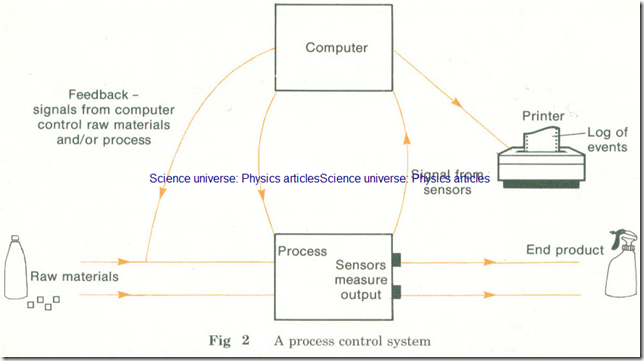Process Control
Process control means automatic control of an industrial process.
Usually the controller consists of a dedicated computer- or a microprocessor-based circuit.
The computer may control the supply of materials and the timing of each part of the process. Usually the control process uses the feedback principle .
Some more sophisticated systems allow for ‘learning’ to take place. The microprocessor ‘remembers’ how the best results were obtained and attempts to reproduce those results.
Process control systems use negative feedback to keep the process stable. Control is carried out as follows:
1 Output from the process is monitored, signals being sent back to the computer.
2 The computer uses this data to adjust the process so that the output remains constant.
In a computerized process control application the following items are generally required:
1 A processor.
2 Display devices (e.g. VOU screens, LED or LCD displays) so that a human operator can check the system.
3 A printer to provide hard copy when required.
4 Sensors to provide information on the process under control (usually analogue in form).
5 Actuators to carry out control action in response to signals from the processor.
6 Digital-to-analogue and analogue-to-digital converters.
Examples of process control
Cement mixing
The computer controls the monitoring and weighing of materials and the speed of mixing.
Fig 2 A process control system
Various mixing recipes are held in memory and these can be changed, or new ones added, when required.
Chemical plant
It is the speed of the microprocessor which is important in this example. Inputs from sensors are received very frequently. This means that control actions can take place swiftly in response to changes. It is usual for every operation in the plant to be monitored at least once per second.
Computer numerically controlled machinery (CNC)
New machines are often built incorporating CNC. An alternative is to fit control equipment to existing machinery, this is called retrofitting. The second option has proved cheaper (about 30 per cent of the cost) and consequently more popular.
CNC machinery is used, for example, in woodworking. The patterns or the original to be copied are traced out and the tracing stored in memory. The tracing in memory is then used to control the cutting of the pattern into the final material.
Advantages of introducing computers to control processes
1 Labour costs are lower. Fewer operators and maintenance staff are required. Often maintenance work is put out to contract.
(Note: All this may not be seen as an advantage by the workers.)
2 A computer-controlled system is more flexible. This means the manufacturer can easily change the product to suit the customer.
3 The system is more reliable. Microprocessors rarely fail and when they do replacement is a relatively simple process.
4 Quality is improved. The quality of raw materials can more easily be monitored. More tests can be carried out during the process and those tests can be carried out more often. This improves the quality of the end product.
5 Safety is improved. The general level of control is improved. In particular ‘fail safes’ can be incorporated into the programs to deal with dangerous conditions. It is also possible to put control equipment into places where it would be unpleasant or even dangerous for a human being to go.
6 Energy is saved. Microprocessors can help ensure that energy is not wasted by monitoring and controlling its use. Where there are no people present there is less need for heating and lighting.
7 Raw materials are saved. When materials costs are significant the microprocessor can be programmed to minimize wastage. For example accurate weighing in the food industry can contribute to considerable savings.
8 For the workers who are left, jobs and conditions are improved. Because an operator is responsible for more than one machine that responsibility is higher. This could mean the pay is higher. Workers usually have cleaner, less hostile conditions.
Disadvantages of introducing computers to control processes
1 Although less staff are required, those that are needed are highly skilled and difficult to find.
2 The cost of initial investment in the new control equipment and software for it may be high.
3 Persuading the workers to accept the new system may not be easy. Even if it is accepted staff will need retraining.

